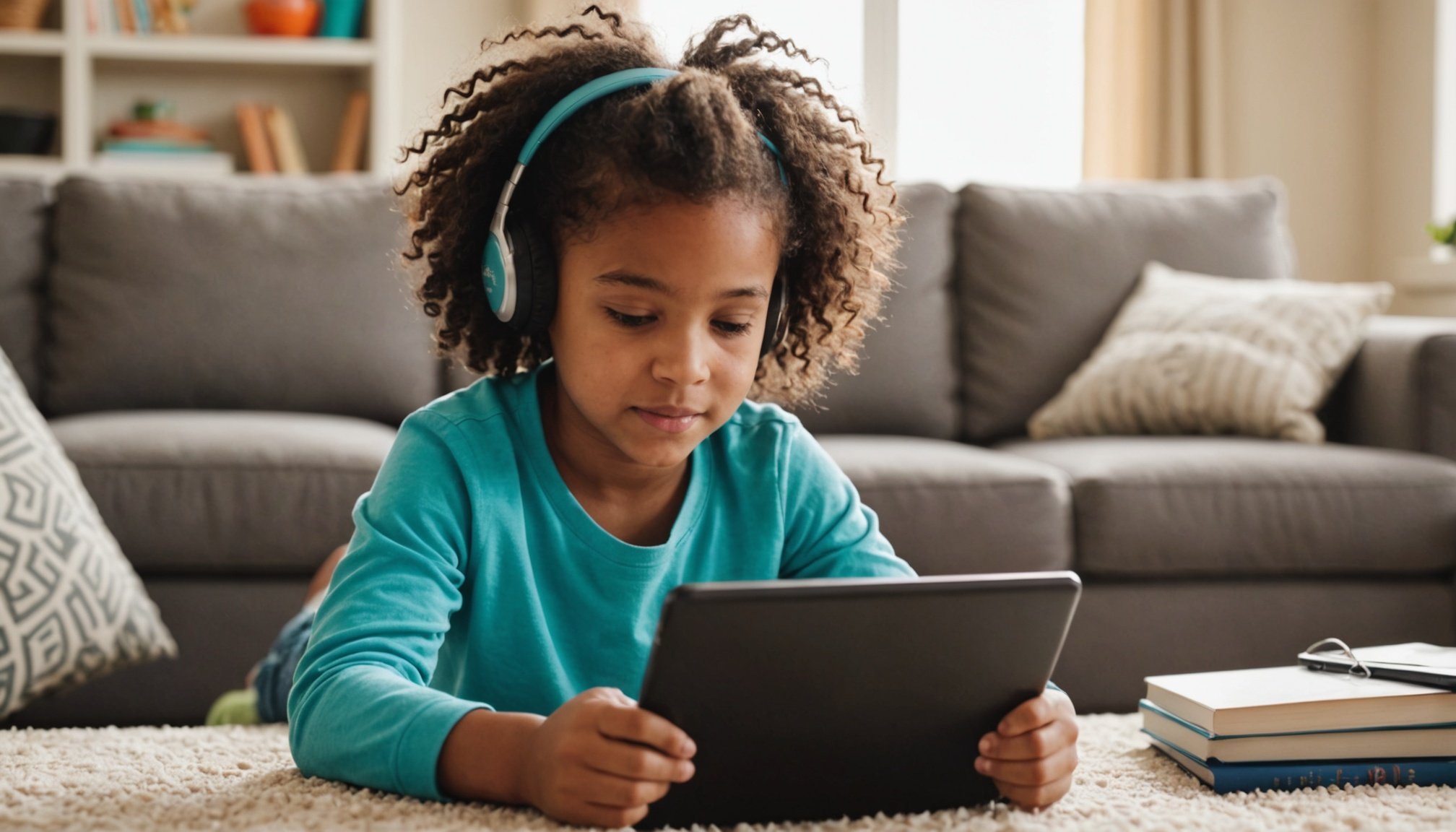Understanding Screen Time and Its Impact
Exploring the world of screen time requires understanding its definitions and classifications. At its core, screen time refers to the amount of time spent on digital devices like smartphones, tablets, and computers. For children, these devices often provide educational content that can support cognitive and emotional development. But what are the overarching benefits and risks associated with screen time?
Positive Impacts on Learning and Development
Screen usage offers several benefits. Educational platforms can enhance children’s learning experiences by providing access to interactive and engaging content. This method often results in improved attention, comprehension, and problem-solving skills. Moreover, digital tools can help develop literacy and numeracy, offering diverse methods to cultivate young minds.
Have you seen this : Reclaim Your Mind: The Impact of Digital Detox on Mental Well-Being and Work Efficiency
Risks of Excessive Screen Time
However, excessive screen time poses significant challenges. Physically, it can lead to issues such as eye strain, poor posture, and reduced physical activity. Mentally, the overuse of screens often correlates with increased anxiety and poor sleep patterns. Especially in developing children, overconsumption may hinder social skill development and lead to behavioural issues. The key is finding a balance, integrating screen usage with active and offline activities, ensuring it is beneficial rather than detrimental to child development.
Setting Screen Time Guidelines
Navigating screen time limits can be challenging, but understanding age-specific recommendations aids in promoting healthy media consumption. Pediatric guidelines highlight the importance of categorizing screen time according to age. For instance, the American Academy of Pediatrics suggests that children aged 2 to 5 years should have no more than one hour of screen time daily, while older children and teens should balance entertainment media with other healthy habits, such as physical activity and sleep.
Also to see : Crafting Your Eco-Friendly Grocery List: A Step-by-Step Guide to Sustainable and Healthy Shopping
Establishing clear screen time limits is critical for maintaining balance. Parents are encouraged to serve as role models and engage in discussions about the significance of screen time with their children. Monitoring usage helps detect if activities such as homework or hobbies are being compromised due to excessive screen time.
To facilitate this, creating a family media use agreement can offer a structured approach. This framework initiates conversations about expectations and responsibilities, ensuring everyone is on the same page. It provides room to set customizable rules that fit the unique needs of each family member while promoting accountability.
By following these recommendations by age, families can adapt to digital advancements mindfully, creating a long-term, sustainable plan for healthy media consumption.
Choosing Age-Appropriate Screen Content
Selecting the right educational content for children is crucial in their development. When considering media, focus on quality programming that promotes learning and engagement.
Apps and Games
Incorporating educational apps and games can provide an interactive learning experience. Look for apps designed for specific age groups, ensuring they align with developmental milestones. Many platforms offer parental controls and educational metrics to support learning.
Television Shows
Television shows can be more than entertainment. Seek out shows that cultivate critical thinking and problem-solving. Programmes like “Blue Peter” or “Sesame Street” are excellent examples, merging fun with educational content.
Online Resources
Reliable online resources offer vast options for child-friendly content. Websites such as PBS Kids and BBC’s CBeebies curate age-appropriate and educational material, providing a safe environment for exploration. Online platforms should be scrutinized for safety features like age verification and content filtering to ensure they present only suitable content.
By making informed media selections, caregivers can provide enriching content that fosters growth and curiosity in a safe and appropriate manner. This approach helps nurture a child’s intellect while making screen time both enjoyable and beneficial.
Encouraging Alternatives to Screen Time
Children today are often drawn to screens, but incorporating non-screen activities is crucial for their development. Physical engagement such as outdoor play promotes health and improves social skills. Activities like playing tag, cycling, or simply exploring nature encourage physical movement and stimulate creativity in young minds. These exercises are not only beneficial for physical wellbeing but also enhance mental acuity and emotional resilience.
Getting creative with imaginative play is also a delightful way to veer away from screens. Simple materials such as blocks, paints, or even household items can spark children’s imagination. Building forts or crafting DIY projects fosters problem-solving skills and creativity, allowing them to invent worlds of their own. These experiences are unforgettable and lay the foundation for cognitive growth.
Engaging children in family board games or storytelling sessions offers another fantastic screen-free alternative. Board games develop strategic thinking and teach the value of teamwork. Moreover, storytelling can hone language skills and stimulate an enduring love for narratives. Family members can exchange tales or devise a continuing saga, transforming screen-less time into memorable and educational entertainment. Ultimately, these activities forge stronger family bonds and instill lasting values.
Fostering Family Interaction and Discussion
In today’s digital age, maintaining a balance in screen time discussions is crucial for healthy family dynamics. Establishing regular family meetings can serve as an effective platform to discuss screen time usage. These gatherings allow family members to express their perspectives and negotiate boundaries that meet everyone’s needs. Family meetings can foster open communication, enabling each member to understand the impact of media consumption and develop essential communication skills.
Engaging in tech-free family activities is another key aspect of promoting family bonding. Ensuring certain times are device-free allows families to connect on a deeper level through shared experiences. Some possible tech-free activities include outdoor adventures, cooking together, reading, board games, and puzzles. These interactions play a fundamental role in building stronger family bonds and mitigating the effects that excessive screen time may have on personal relationships.
It’s equally important to address the importance of open communication about media consumption and its effects. By keeping communication channels open, families encourage honesty and understanding around the potential impacts of technology. Discussing these topics regularly can help mitigate misunderstandings and ensure that all family members feel valued and heard, strengthening family unity. Emphasizing both communication skills and family bonding, these practices foster a harmonious household environment.
Monitoring and Adapting Screen Time Management
Effective tracking of screen time is pivotal in fostering healthy digital habits. A host of tools and apps now exist to assist parents in monitoring children’s screen time. These applications not only log the duration children spend on devices but also pinpoint specific activities. By employing these tools, parents can better understand their child’s screen interaction and make data-driven adjustments.
Adapting strategies and making progress assessments regularly is essential. Screen time limits are not one-size-fits-all; what works one month may need tweaking the next. Hence, it’s crucial for parents to review the effectiveness of these limits systematically. Engaging in open discussions with children about their screen habits allows for a mutual exchange of expectations and observations. These dialogues can enhance self-regulation, encouraging children to develop a sense of responsibility towards their screen use.
Incorporating children into conversations about their screen time behaviors promotes an understanding of balance and moderation. When they take part in setting their own limits, they learn to manage their activities consciously. Such experiences empower young individuals, equipping them with lifelong skills to handle technology responsibly. Building these foundations today is an investment in their overall well-being tomorrow.











